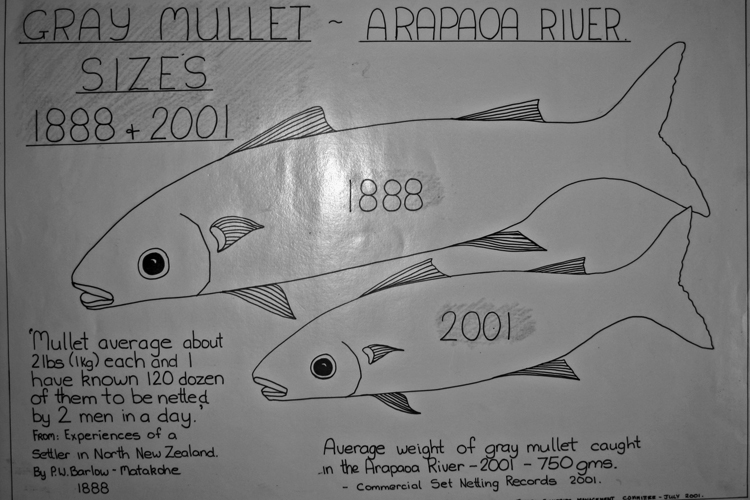Fisheries
The longterm objective to restore sustainable use of fish and invertebrate stocks is defined as managing use of Kaipara Harbour fisheries, including invertebrate/shellfish, within a manner that achieves local aspirations and values; manages fisheries activities for system functioning rather than as a commodity; management has a longterm perspective and is integrated.

(Image: C Yardley, 2000)
Issue:
The Kaipara Harbour is New Zealand's largest enclosed estuary and the second largest harbour in the world (Haggitt et al. 2008), has long been recognised as an important nursery area for juvenile fish and sharks, particularly snapper, grey mullet, flounder and mako and great white sharks. Early European explorers and settlers to the Kaipara commented on the bounty of the harbour ecosystem. Evidence of this is described from explorers’ journals, ship’s logs, and settler narratives. The record shows that Kaipara Māori were indeed fine fishermen and were capable of operating on large-scales, with enormous nets, to capture schools of fish. There exists a significant cultural and spiritual relationship to Kaipara fisheries for Ngāti Whātua hapū Te Uri o Hau and Ngāti Whātua Ngā Rima o Kaipara. Kaipara hapū readily refer to the Kaipara as their ‘food basket’ and family member.
Through a combination of increasing part-time fishers, the ability to work many areas of the Kaipara in various weather conditions, trawling and long-lining operating along and adjacent to the Kaipara entrance, and changing fishing rules, brought growing conflict on the harbour (KHSFMSG 2003). The fishery has been subject to many attempts to manage the conflict and fishing pressure however, declining fish stocks, particularly snapper, grey mullet, eel, toheroa, flounder and rig are a concern to the sustainability of commercial fishing in the harbour. The unknown status of their relative biomass is of particular concern, which provides tremendous uncertainty to the future of these stocks. In addition, information, which would assist management decisions, is lacking (Haggitt et al. 2008).
The Kaipara estuarine ecosystem has a significant role in the wider West Coast North Island ecosystem particularly as a natal nursery ground for snapper (SNA8), and most likely grey mullet (GMU1) and school shark (SCH1) stocks.
The Kaipara marine estuarine ecosystem contributes an outstanding example of intact seagrass meadows to the West Coast North Island ecosystem. Little information exists on fisheries habitat within the Kaipara especially the relationship with fish habitat connectivity throughout the life-cycle of species.
The use of Mātauranga Māori (traditional knowledge) in the current management regime and policy framework is lacking. Avenues for this to exist are possible but have yet to be established.
There is a strong desire within Ngāti Whātua ki Kaipara (Hapū) and local fishing community for a co-managed fishery. However, there is no room for local management or co-management arrangements to exist under the New Zealand fisheries legislation.
Strategy:
To restore sustainable Kaipara fisheries stock requires an ecosystem-based management approach where management recognises the natural boundaries of ecosystems rather than jurisdictional boundaries. The approach also includes moving from being species-focused to ecosystem-focused and requires a balance of spatially protected areas with general fishing areas. To support implementation the approach must be grounded in both worldviews.
Goals:
- Pro-active spatial management and planning that will benefit local fish populations (or sub-stocks), fisheries habitats and shellfish.

